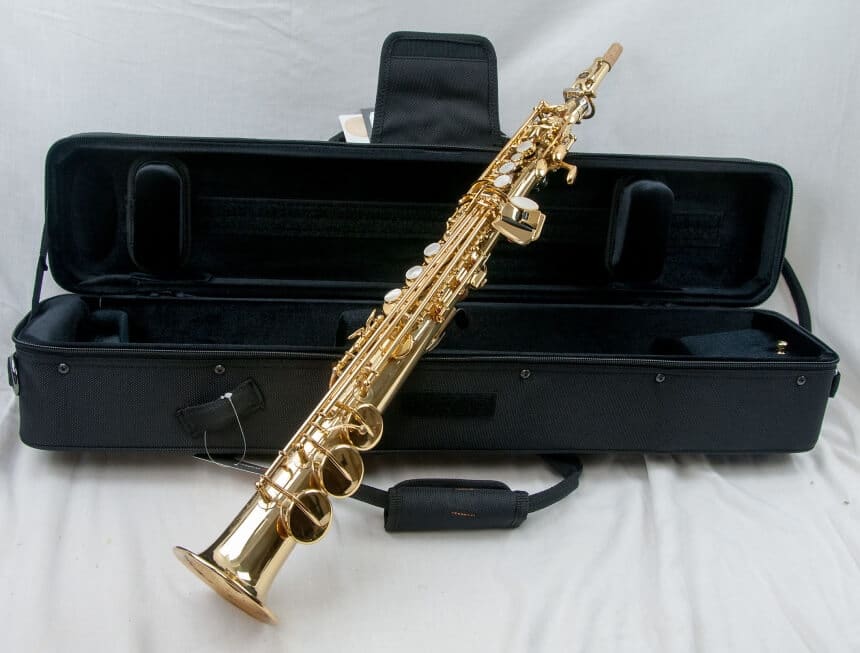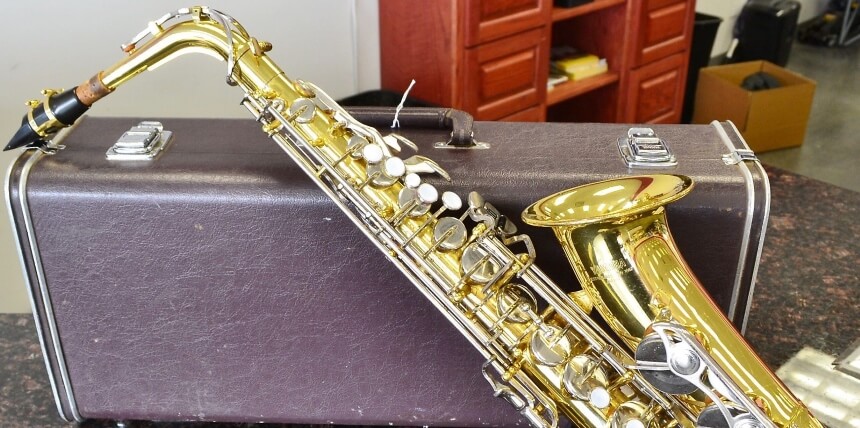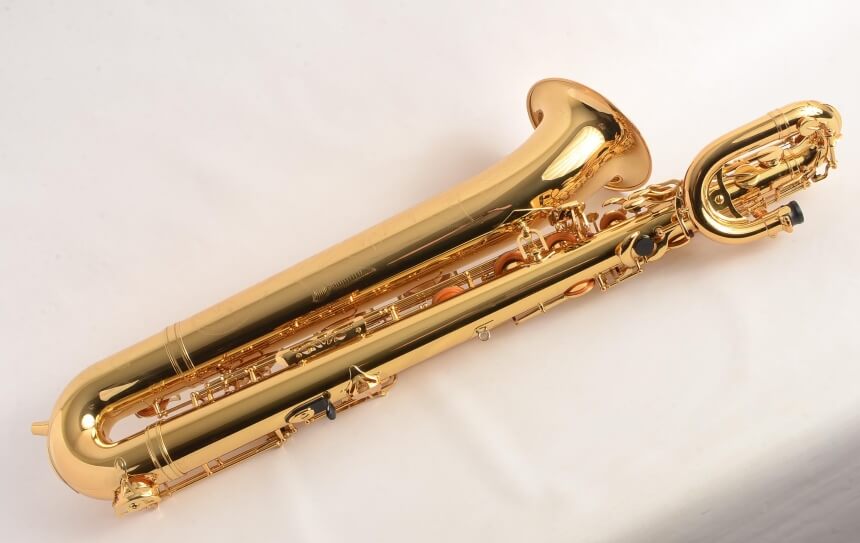Did you know that the saxophone is one of the most recent non-electrical musical instruments? It was invented in the late 19th century when the world already had its eyes on electric instruments and electric variants of existing instruments. Since its invention, it has been tweaked and produced in different forms and sizes. Originally, there were 14 different types of saxophones because Adolphe Sax, the inventor, had envisioned an orchestra consisting only of saxophones.
Saxophones are generally used in jazz, swing, military, and concert bands. Lately, you will hear them in pop songs and orchestral music.
 This is the smallest of the 4 main saxophones. It is a Bb instrument, and it is deemed the hardest sax to play. It comes in 2 forms: curved or straight, and is pretty short. It is its short length that actually makes it hard to tune accurately. In fact, it is not considered a beginner-friendly instrument because it allows a short margin for error.
This is the smallest of the 4 main saxophones. It is a Bb instrument, and it is deemed the hardest sax to play. It comes in 2 forms: curved or straight, and is pretty short. It is its short length that actually makes it hard to tune accurately. In fact, it is not considered a beginner-friendly instrument because it allows a short margin for error.
The soprano sax is considered a second instrument because it is not included as standard in jazz band sets, swing, or concerts. It resembles a clarinet, and it often plays the parts of a clarinet in a band. However, it does produce a louder and more penetrating sound than a clarinet at the higher end of a scale.
The curved Soprano is famously used by tutors for children too young for the Alto. If you are looking to get a soprano saxophone as your second instrument, consider the popular Selmer SSS280R La Voix II Soprano Saxophone. It is highly recommended by experts for its compact key design and professional spring tension. It features leather pads and has multiple adjustment screws for top-notch convenience.
 This is the most popular type of saxophone out there. It is popularly known as one of the key instruments in jazz music evolution. It is pitched in Eb and is highly preferred by many because it is affordable, easy to learn, and has a perfect size. Virtually any sax player you meet will attest to learning their trade using the Alto saxophone.
This is the most popular type of saxophone out there. It is popularly known as one of the key instruments in jazz music evolution. It is pitched in Eb and is highly preferred by many because it is affordable, easy to learn, and has a perfect size. Virtually any sax player you meet will attest to learning their trade using the Alto saxophone.
The Alto saxophone shares some similarities with the baritone and the tenor saxophones. It has their upturned bell characteristics. It is usually played in front of the saxophonist.
The sax is commonly used in jazz bands, military bands, swing bands, rock and roll bands, chamber groups, and marching groups.
Users recommend the Yamaha YAS-480 Intermediate Eb Alto Saxophone as the best reliable and valuable saxophone in terms of performance and affordability. It is also highly acclaimed by top reviewers as a high-quality bright sounding saxophone. The sax comes in an incredibly lightweight yet sturdy body and features a professional-grade 62-style neck that offers a mature sound quality. Plus, it has a touch of class thanks to its hand-engraved pattern.
This is just as popular as the alto saxophone. It is the second largest of all the 4 most commonly used saxophones. It looks like the alto sax, only it has a curved neck, and it is larger. It is a Bb instrument and is highly preferred for its ability to add some depth to the music.
Playing the tenor saxophone is pretty similar to playing the alto sax, except it requires more air to be blown through the mouthpiece. This is why it is not a popular beginner option, especially for small children who still have less developed lungs.
Most people who purchase a tenor saxophone are usually skilled players looking for an instrument that will last them as their playing advances. You will hear a tenor saxophone in pop and jazz music. In jazz bands, it is referred to as jazz tenor because it is featured in elaborate solos. John Coltrane, Sonny Rollins, and Michael Brecker are some of the renowned tenor saxophone players.
The tenor saxophone is played on the side like the baritone saxophone. The Jean-Paul USA Intermediate Tenor Saxophone TS-40 is the most acclaimed tenor saxophone by expert reviewers and users. It is loved by many for its tapered pivot keys that offer easy playability. It also has an attractive yellow brass body and a lovely engraved bell pattern that will set you apart in the band. As if that’s enough, the sax comes with a contoured carrying case for easy transportation.
 This is the cat’s pajamas of the entire saxophone spectrum. It is the largest of the 4 and is pitched in Eb. Because of its large size, it requires a large volume of air to produce its full range of notes. Therefore, it is by no chance a beginner-friendly option. Only advanced players can pull it off well.
This is the cat’s pajamas of the entire saxophone spectrum. It is the largest of the 4 and is pitched in Eb. Because of its large size, it requires a large volume of air to produce its full range of notes. Therefore, it is by no chance a beginner-friendly option. Only advanced players can pull it off well.
Because of its relatively heavyweight (about 6-7kgs), it is often held in a harness. It plays the bass line in a band, and you will mostly see it in classical music. It isn’t that popular in orchestral music.
Some of the best known Baritone saxophone players include Pepper Adams, Gerry Mulligan, and Gary Simulyan.
The Baritone sax costs a pretty penny, and that’s probably why the big wig companies like
Yamaha
Trusted Source
Musical Instruments - Products - Yamaha USA
Make Waves
usa.yamaha.com
and
Jupiter
Trusted Source
Jupiter Music - Home
Built for effortless response
jupitermusic.com
dominate the market. The Yamaha YBS-62 Professional Baritone Saxophone is one of the best-rated professional saxophones. It has received all the rave reviews from professional saxophone players and top reviewers alike for having unrivaled sound quality. It features an annealed bell that sets it apart in terms of sound quality. Its gold epoxy lacquer finish screams class and luxury. Its adjustable thumb-rest will give you the easiest time playing the beastly sax.
 There are several other types of saxophones other than the 4 popular types. However, you will hardly hear them in popular music. They include the sopranissimo, sopranino, bass, contrabass, and sub-contrabass saxophones.
There are several other types of saxophones other than the 4 popular types. However, you will hardly hear them in popular music. They include the sopranissimo, sopranino, bass, contrabass, and sub-contrabass saxophones.
These saxophones are basically variants of the Eb and Bb transposing saxophones. They are extremely pricey and impractical, and that’s why only a few people collect and play them.
Another rare saxophone is the C-Melody. It was a thing in the 20th century, but there are some new ones being produced currently. It is a non-transposing instrument. You can actually look over the shoulder of a piano player and play along to his tune without having to transpose.
Other than the Bb and the Eb, saxophones were also produced in the C and F keys. The ones originally pitched in C and F key were meant to be in orchestras, while the ones pitched in Eb and Bb were meant for bands. In terms of shape, the alto and the tenor saxophones have also been produced in the straight form. In terms of material, there have been more than just brass saxophones. Some have been made out of wood, plastic, and even polycarbonate.
There are different types of saxophones out there, and understanding each of them gives you the power to tell them apart whether you are an upcoming professional player or you love attending jazz concerts. We have provided in-depth information about the saxophone variants, both the common and the uncommon ones.
What’s more, the knowledge will help you learn your trade pretty fast since you have to know the different types of saxophone sounds before choosing one to specialize in or call your ‘main.’ As common with most players, as your skills advance, you will realize that you can easily pick out the saxophones even when presented with different types of saxophone pictures.